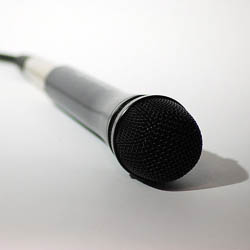
VOCAL
• Place a flat condenser mic 8 inches away at eye height to avoid breath pops.
• Or place the mic at mouth height and mount a hoop-type pop filter a few inches out front.
SINGING GUITARIST
• Mike the singer up close using a cardioid dynamic or condenser mic with either a flat mic or a mic with a presence peak. Add a foam pop filter.
Turn down the extra bass with your mixer’s EQ. Put a similar mic near the guitar, aiming at the fingerboard about 3 inches away, about 3 inches to the right of the sound hole. Turn down the extra bass with your mixer’s EQ.
• Best-sounding method: Record the guitar first, then overdub the vocal with a flat condenser mic.
• Record the vocal and guitar with a single flat condenser mic (or stereo mic or stereo pair) midway between the mouth and guitar. Adjust mic height to control the balance between guitar and voice.
• Use a mini mic or pickup on the guitar and a cardioid mic on the vocal.
• If the voice sounds filtered due to delayed leakage into the guitar mic, delay the vocal track about 1 msec.
ACOUSTIC GUITAR
• Attach a mini omni mic to the guitar soundboard, halfway between the bridge and the sound hole, 1/2” from the low E string, not under the strings.
• Place a flat condenser mic 6 to 12 inches from where the fingerboard joins the body. For stereo, add another mic the same distance from the bridge. For more isolation, mike 3 inches from the end of the fingerboard.
SAX
• Place a flat condenser or flat dynamic mic 18 inches away, a few inches above the bell, toward the player’s right side.
• Clip a mini mic to the top of the bell, and place the mic to pick up both the bell and the tone holes.
ELECTRIC GUITAR OR ELECTRIC BASS (RECORDED DIRECT)
• For a clean sound, plug the guitar into a direct box. Plug the direct-box output into a mixer mic input. For a distorted sound, plug into a guitar signal processor. Plug the processor output into a mixer line input. Or record direct, and use a guitar-amp modeling plug-in.
ELECTRIC GUITAR AMP
• Place a cardioid dynamic mic with a presence peak, or a ribbon mic, 1 inch from a speaker cone, slightly off-center. For the brightest tone, place the mic near the center of the speaker cone. For a mellower tone, place the mic near the edge of the speaker cone.
SYNTHESIZER OR DRUM MACHINE
• Using guitar cords, connect the synth left/right outputs to two line inputs on your mixer.
• Plug a guitar cord into each output. Connect each guitar cord to a direct box. Connect each direct-box output to a mic input on your mixer. On the direct box, flip the ground-lift switch to the position where you hear the least hum in the monitored signal.
